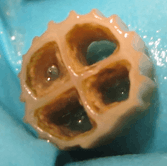Moving bed biofilm reactor
Moving bed biofilm reactor (MBBR) is a type of wastewater treatment process that was first invented by Prof. Hallvard Ødegaard at Norwegian University of Science and Technology in the late 1980s.[1] It was commercialized by Kaldnes Miljöteknologi (now called AnoxKaldnes and owned by Veolia Water Technologies). There are over 700 wastewater treatment systems[2] (both municipal and industrial) installed in over 50 countries. Currently, there are various suppliers of MBBR systems.[3]

Process description
Overview
The MBBR system consists of an aeration tank (similar to an activated sludge tank) with special plastic carriers that provide a surface where a biofilm can grow. The carriers are made of a material with a density close to the density of water (1 g/cm3). An example is high-density polyethylene (HDPE) which has a density close to 0.95 g/cm3. The carriers will be mixed in the tank by the aeration system and thus will have good contact between the substrate in the influent wastewater and the biomass on the carriers.[2] To prevent the plastic carriers from escaping the aeration it is necessary to have a sieve on the outlet of the tank. To achieve higher concentration of biomass in the bioreactors, hybrid MBBR systems have also been used where suspended and attached biomass co-exist contributing both to biological processes.[4] There are also anaerobic MBBRs that have been mainly used for industrial wastewater treatment.[5] Recently, a combination of anaerobic (methanogenic) MBBR with aerobic MBBR was applied in the laboratory for municipal wastewater treatment with simultaneous production of biogas.[6]
Advantages
The MBBR system is considered a biofilm process. Other conventional biofilm processes for wastewater treatment are called trickling filter, rotating biological contactor (RBC) and biological aerated filter (BAF). Biofilm processes in general require less space than activated sludge systems because the biomass is more concentrated, and the efficiency of the system is less dependent on the final sludge separation. A disadvantage with other biofilm processes is that they experience bioclogging and build-up of headloss. [1]
MBBR systems don't need a recycling of the sludge, which is the case with activated sludge systems.
The MBBR system is often installed as a retrofit of existing activated sludge tanks to increase the capacity of the existing system. The degree of filling of carriers can be adapted to the specific situation and the desired capacity. Thus an existing treatment plant can increase its capacity without increasing the footprint by constructing new tanks.
When constructing the filling degree can be set to, for example, 40% in the beginning, and later be increased to 70% by filling more carriers. Examples of situations can be population increase in a city for a municipal wastewater treatment plant or increased wastewater production from an industrial factory.
Some other advantages compared to activated sludge systems are:[7]
- Higher effective sludge retention time (SRT) which is favorable for nitrification
- Responds to load fluctuations without operator intervention
- Lower sludge production
- Less area required
- Resilient to toxic shock
- Process performance independent of secondary clarifier (due to the fact that there is no sludge return line)
Large diameter submersible mixers are commonly used as a method for mixing in these systems.
Experiments with moving bed biofilm reactors have also shown that these systems achieve partial removal of organic micropollutants from the wastewater [8][9][10]
References
- Ødegaard, H.; Rusten, B.; Westrum, T. (October 1994). "A new moving bed biofilm reactor - applications and results". Water Science and Technology. 29 (10–11): 157–165. doi:10.2166/wst.1994.0757.
- Ødegaard, Hallvard (2012). Vann- og Avløpsteknikk. Norsk Vann. ISBN 9788241403361.
- Haandel, Adrianus C. van; Lubbe, J. G. M. van der (2012-01-01). Handbook of Biological Wastewater Treatment: Design and Optimisation of Activated Sludge Systems. IWA Publishing. ISBN 9781780400006.
- Mazioti, Aikaterini A.; Stasinakis, Athanasios S.; Psoma, Aikaterini K.; Thomaidis, Nikolaos S.; Andersen, Henrik R. (February 2017). "Hybrid Moving Bed Biofilm Reactor for the biodegradation of benzotriazoles and hydroxy-benzothiazole in wastewater". Journal of Hazardous Materials. 323 (Pt A): 299–310. doi:10.1016/j.jhazmat.2016.06.035. PMID 27396311.
- di Biase, A.; Devlin, T.R.; Kowalski, M.S.; Oleszkiewicz, J.A. (June 2018). "Performance and design considerations for an anaerobic moving bed biofilm reactor treating brewery wastewater: Impact of surface area loading rate and temperature". Journal of Environmental Management. 216: 392–398. doi:10.1016/j.jenvman.2017.05.093. PMID 28595913.
- Kora, Elianta; Theodorelou, Danai; Gatidou, Georgia; Fountoulakis, Michail S.; Stasinakis, Athanasios S. (September 2019). "Removal of polar micropollutants from domestic wastewater using a methanogenic – aerobic Moving Bed Biofilm Reactor system". Chemical Engineering Journal: 122983. doi:10.1016/j.cej.2019.122983.
- Burton, Franklin; Tchobanoglous, George; Tsuchihashi, Ryujiro; Stensel, H. David; Inc, Metcalf & Eddy (2013-09-03). Wastewater Engineering: Treatment and Resource Recovery. McGraw-Hill Education. ISBN 9780073401188.
- Mazioti, Aikaterini A.; Stasinakis, Athanasios S.; Pantazi, Ypapanti; Andersen, Henrik R. (1 September 2015). "Biodegradation of benzotriazoles and hydroxy-benzothiazole in wastewater by activated sludge and moving bed biofilm reactor systems". Bioresource Technology. 192: 627–635. doi:10.1016/j.biortech.2015.06.035. PMID 26093257.
- Casas, Mònica Escolà; Chhetri, Ravi Kumar; Ooi, Gordon; Hansen, Kamilla M.S.; Litty, Klaus; Christensson, Magnus; Kragelund, Caroline; Andersen, Henrik R.; Bester, Kai (October 2015). "Biodegradation of pharmaceuticals in hospital wastewater by staged Moving Bed Biofilm Reactors (MBBR)". Water Research. 83: 293–302. doi:10.1016/j.watres.2015.06.042. PMID 26164801.
- Polesel, Fabio; Torresi, Elena; Loreggian, Luca; Casas, Mònica Escolà; Christensson, Magnus; Bester, Kai; Plósz, Benedek Gy. (October 2017). "Removal of pharmaceuticals in pre-denitrifying MBBR – Influence of organic substrate availability in single- and three-stage configurations". Water Research. 123: 408–419. doi:10.1016/j.watres.2017.06.068. PMID 28689125.